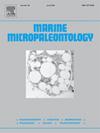Appraisal of middle Floian (Lower Ordovician) conodont diversity of the Precordillera and Cordillera Oriental, Argentina: Paleobiogeographical implications
Abstract
In this paper we compare the diversity of Floian (Lower Ordovician) conodonts from the Precordillera with that of the Cordillera Oriental, Argentina. The comparative analysis is restricted to the middle Floian Stage Slice (Fl2) from correlative intervals: Oepikodus evae Zone (Juanognathus variabilis Subzone) in the Precordillera and the Gothodus andinus Zone in the Cordillera Oriental. For the comparative analysis, absolute frequency tables of the conodont data from published articles and collections under study, were prepared. These include four sections of the Precordillera with 13 samples recovered from the middle section of the carbonate San Juan Formation, and six sections of the Cordillera Oriental with 28 samples from the middle-upper section of the shaly Acoite Formation. Diversity patterns and indices were generated from absolute frequencies using the software PAST 4.03. Remarkable differences in the species richness and diversity between coeval communities of referred basins are displayed. Comparisons with other basins elsewhere suggest that the paleolatitudinal gradient is not a major factor controlling changes in diversity, which may be due to a response to the complex interaction of biological and physico-chemical factors.

 求助内容:
求助内容: 应助结果提醒方式:
应助结果提醒方式:


